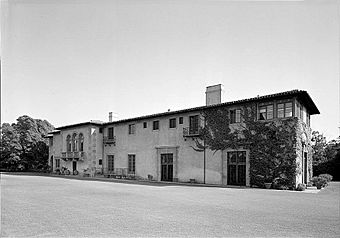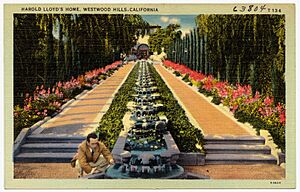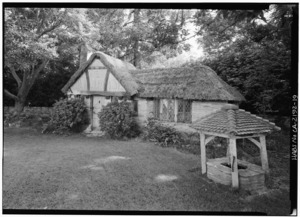Harold Lloyd Estate facts for kids
|
Greenacres – Harold Lloyd Estate
|
|

Greenacres, Harold Lloyd Estate in 1974
|
|
| Lua error in Module:Location_map at line 420: attempt to index field 'wikibase' (a nil value). | |
| Location | 1740 Green Acres Drive, Beverly Hills, California 34°5′17″N 118°25′37″W / 34.08806°N 118.42694°W |
|---|---|
| Built | 1928 |
| Architect | Webber, Staunton & Sumner Spaulding |
| Landscape architect | A.E. Hanson |
| Architectural style | Mediterranean Revival architecture |
| NRHP reference No. | 84000876 |
Quick facts for kids Significant dates |
|
| Added to NRHP | February 9, 1984 |
The Harold Lloyd Estate, also known as Greenacres, is a huge mansion and beautiful estate. It is located in the Benedict Canyon area of Beverly Hills, California. This amazing home was built in the late 1920s by the famous silent film star Harold Lloyd. He lived there until he passed away in 1971.
Originally, the estate was enormous, covering about 15 acres. It included a 44-room mansion, a golf course, other buildings, and even a 900-foot canoe run! Greenacres has been called "the most impressive movie star's estate ever created." After Lloyd's death, some of the land was sold off for new homes. However, the main mansion still sits on about 5 acres of its original land. In 1984, Greenacres was added to the National Register of Historic Places, which means it's a very important historical site.
Contents
Building a Dream Home
In May 1923, Harold Lloyd bought the land for his future estate. It was located in Beverly Hills, near where other famous stars like Mary Pickford and Douglas Fairbanks had built their home, Pickfair. Lloyd paid $100,000 for the property.
In August 1925, Lloyd shared his exciting plans. He wanted to build a huge estate that would cost $1 million. It would feature a three-story home in the French-Italian Renaissance style. The plans also included a nine-acre golf course and a massive swimming pool. This pool, measuring 50 by 150 feet, was planned to be the biggest in Southern California!
Lloyd hired Sumner Spaulding as the architect for the house. For the outdoor areas, he brought in landscape engineer A.E. Hanson. Hanson was tasked with creating the "largest initial private landscaping project ever attempted" in Los Angeles. His designs included beautiful gardens and a stream. Water would be pumped to the top of a hill and then flow down through the property. This stream even created water hazards for the golf course.
Construction of the mansion began in July 1927 and was finished in 1928. The entire estate, including the 45,000-square-foot house, was said to have cost $2 million.
Amazing Features of Greenacres
A.E. Hanson, the landscape architect, turned the 15-acre property into a stunning paradise. He took inspiration from famous Italian villas to create a Mediterranean Revival and Spanish Revival look. The Los Angeles Times newspaper called it a "gorgeous fairyland playground" and a "Modern Eden."
The estate's grounds and gardens had many incredible features:
- A private nine-hole golf course.
- A 900-foot canoe stream filled with fish like trout and bass. It also had a 100-foot waterfall!
- The largest swimming pool in Southern California, measuring 50 by 150 feet. This pool was very modern for its time. It even had a tunnel around it with underwater windows. You could watch or photograph swimmers from inside the tunnel!
- Many different types of gardens. These included tropical forests, sunken gardens, formal gardens, rose gardens, and Italian gardens.
- Stables for horses, cattle, and sheep. There was also a small farm where fruits and vegetables were grown. Greenhouses were used for growing flowers.
- An outdoor theater and a dance area.
- Two special vaults to store original copies of Harold Lloyd's films.
- Tennis courts, an outdoor bowling green, and a handball court. Harold Lloyd was a national handball champion!
- A large entrance court for cars, measuring 120 feet square.
To create these amazing landscapes, 3,500 tons of sandstone were brought from quarries. This stone was used for steps, terraces, and waterfalls.
A Fairyland for Kids
One of the most unique parts of Greenacres was a special "fairyland estate" built just for Lloyd's four-year-old daughter, Mildred Gloria. This play village had its own private gate with a sign that said, "Come into my garden and play."
The fairyland included:
- A miniature four-room old English-style house.
- A tiny old English stable with a pony and cart.
- Great Dane dogs.
- A wishing well that provided water for her garden.
- A slide, acrobatic equipment, and a swing.
The miniature house was fully equipped with electricity, a kitchen, and a bathroom with running water. Lloyd's daughter and her friends, including child star Shirley Temple, loved to play there.
Life at Greenacres
Harold Lloyd named his estate Greenacres, and it became a popular spot for his family and friends. Sundays were known as "at home" days. On these days, 30 or 40 friends would gather in the afternoon. They would enjoy golf, tennis, handball, swimming, or walks through the gardens. A buffet meal would be served, and in the evening, Lloyd would often show a movie.
In 1937, Mrs. Lloyd hosted a bridal shower at the estate for actress Jeanette MacDonald. Many famous Hollywood stars attended, including Ginger Rogers, Mary Pickford, Irene Dunne, Fay Wray, Norma Shearer, Dolores del Río, Loretta Young, and Darryl Zanuck.
In his later years, Harold Lloyd lived a quiet life at Greenacres. He would start each day with a jog around the grounds, followed by a swim. He also loved listening to music very loudly, which sometimes caused gold leaf to fall from the living room ceiling!
Lloyd lived at the estate until he passed away in 1971 at the age of 77. A long-time staff member shared an interesting story. Lloyd was very superstitious about driving around the Italian fountain in the front court. He always made his chauffeur back up instead of circling it. The staff member noted, "the only time he ever went around that fountain was the night he died."
Greenacres Today
Attempts to Preserve the Estate
Harold Lloyd wanted his estate to be used "for the benefit of the public." He hoped it would become an "educational facility and museum for research into the history of the motion picture." For a few years, the home was open for public tours. However, it faced financial and legal problems, so the museum idea didn't work out. Neighbors in the wealthy community also didn't want a museum that would attract many visitors and parties.
In October 1972, the Los Angeles Times visited the property. They noted that it felt like a scene from the movie Sunset Boulevard. It seemed as if time had stopped in 1929. Nothing had been moved or changed, from the books in the library to the kitchen appliances. Columnist Jack Smith visited in 1973 and wrote that Lloyd's clothes were still in his closet. The master bedroom and living room "looked like a set for a movie of the 1930s." A special tapestry given to Lloyd by Mary Pickford and Douglas Fairbanks was still hanging in the hallway.
The house also had Harold Lloyd's permanent Christmas tree. It was always decorated with ornaments at the end of a long sitting room. Jack Smith described it as "the most fantastic Christmas tree I had ever seen." It reached the ceiling and was covered in huge, colorful glass ornaments.
Sale and Changes
Since a museum couldn't be created, the estate was sold at auction in 1975. An Iranian businessman, Nasrollah Afshani, bought the entire property for $1.6 million. This was less than what Lloyd had spent to build it 50 years earlier. Afshani then divided the estate into about 15 smaller lots, keeping the mansion on its own section. Some of these individual lots sold for as much as $1.2 million.
The main mansion, now on a smaller 5-acre piece of land, was sold in 1979 for $3 million. In 1986, Ted Field, who was an heir to the Marshall Field department store chain and head of Interscope Films, bought the property for $6.5 million. He lived there with his family. The Fields completely updated and renovated the home and grounds. They even added a new swimming pool, as the original one was on the land that had been sold off. They replaced all the electrical wiring and plumbing and modernized the kitchens and bathrooms. They also added an 80-year-old carousel with hand-carved horses to the children's play yard.
In 1993, billionaire Ron Burkle bought the home for $20 million. This was still one of the highest prices paid for a home in the United States at that time. In 2001, the mansion was estimated to be worth between $50 million and $60 million.
Today, the main house and its beautiful gardens are often used for charity events. They are also a popular location for filming movies. You might have seen Greenacres in films like Commando and Westworld.
California Historical Landmark Marker
A special marker, NO. 961, stands at the site. It explains the history of Greenacres:
- O. 961 HAROLD LLOYD ESTATE (GREENACRES) - Greenacres, one of the greatest estates of Hollywood's Golden Era, was built in 1929 for the internationally known silent screen comedian, Harold Lloyd. With its formal gardens, it is one of the finest Mediterranean/Italian Renaissance style residential complexes remaining in the state. The 44-room house was designed by Sumner Spaulding and the gardens planned by A. E. Hansen. The estate is patterned after the Villa Gamberaia near Florence, Italy.
Images for kids








